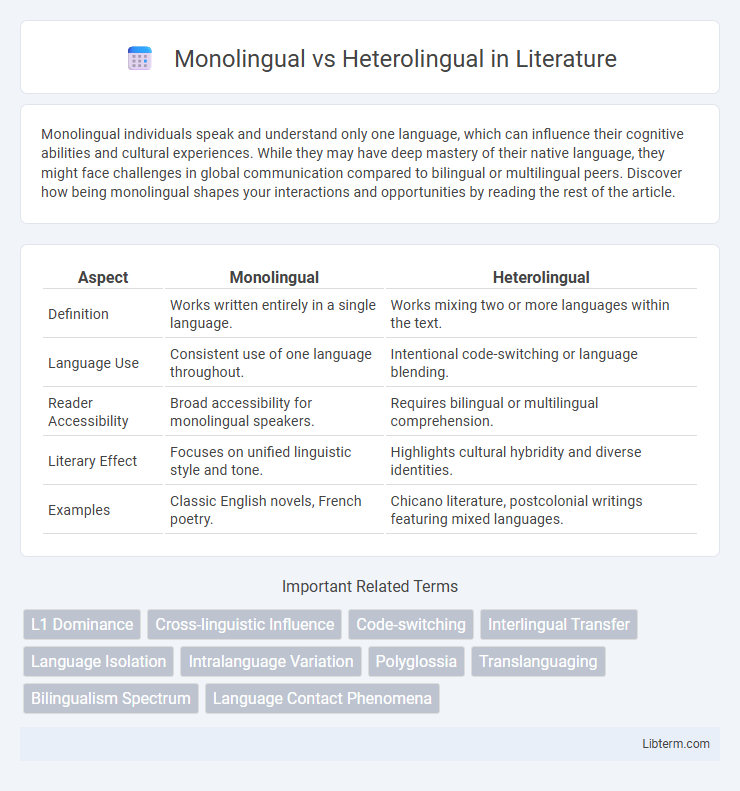Monolingual individuals speak and understand only one language, which can influence their cognitive abilities and cultural experiences. While they may have deep mastery of their native language, they might face challenges in global communication compared to bilingual or multilingual peers. Discover how being monolingual shapes your interactions and opportunities by reading the rest of the article.
Table of Comparison
| Aspect | Monolingual | Heterolingual |
|---|---|---|
| Definition | Works written entirely in a single language. | Works mixing two or more languages within the text. |
| Language Use | Consistent use of one language throughout. | Intentional code-switching or language blending. |
| Reader Accessibility | Broad accessibility for monolingual speakers. | Requires bilingual or multilingual comprehension. |
| Literary Effect | Focuses on unified linguistic style and tone. | Highlights cultural hybridity and diverse identities. |
| Examples | Classic English novels, French poetry. | Chicano literature, postcolonial writings featuring mixed languages. |
Introduction to Monolingualism and Heterolingualism
Monolingualism refers to the ability of an individual to speak and understand only one language, often resulting in deep cultural and linguistic immersion within a single linguistic community. Heterolingualism, on the other hand, involves the use or coexistence of multiple languages in communication, reflecting diverse linguistic environments and promoting multilingual competence. These linguistic frameworks influence cognitive processes, social interactions, and cultural identity, with monolingualism emphasizing language uniformity, while heterolingualism highlights linguistic diversity and adaptability.
Defining Monolingualism: Characteristics and Examples
Monolingualism refers to the ability of an individual or community to use only one language fluently, often characterized by exclusive reliance on a single linguistic system for communication, cultural expression, and daily activities. Typical examples of monolingual contexts include rural areas or nations with a dominant official language, such as Japan or Iceland, where citizens predominantly speak one language with limited exposure to others. Understanding monolingualism involves examining cognitive, social, and educational factors that impact language acquisition and usage within homogenous linguistic environments.
Understanding Heterolingualism: Key Features
Heterolingualism involves the simultaneous use of multiple languages or language varieties within a single communicative context, reflecting cultural diversity and linguistic plurality. Key features include code-switching, where speakers alternate between languages, and translanguaging, which blends linguistic elements to create new forms of expression. Understanding heterolingualism is essential for addressing multilingual communication dynamics, language policy, and education in globalized societies.
Cognitive Implications: Monolingual vs Heterolingual Speakers
Monolingual speakers often demonstrate streamlined cognitive processing within a single linguistic framework, resulting in faster lexical retrieval and fewer memory interferences. Heterolingual individuals engage in complex cognitive control mechanisms to manage multiple languages, enhancing executive functions such as task switching, inhibitory control, and working memory. Studies reveal that bilingualism fosters neuroplasticity and resilience against age-related cognitive decline, highlighting significant cognitive advantages over monolingualism.
Social and Cultural Perspectives
Monolingual societies often experience limited cultural exchange and may face challenges in global communication due to a lack of linguistic diversity. Heterolingual communities foster multiculturalism and social integration, promoting understanding through diverse languages and cultural expressions. Embracing heterolingualism enhances cognitive flexibility and facilitates cross-cultural dialogue, strengthening social cohesion in increasingly interconnected societies.
Educational Outcomes and Language Learning
Monolingual education, emphasizing a single language, often leads to foundational proficiency but may limit cognitive flexibility and cross-cultural communication skills. Heterolingual approaches, incorporating multiple languages, enhance metalinguistic awareness, promote cognitive benefits such as problem-solving and creativity, and improve academic achievement and global competence. Research indicates that learners exposed to heterolingual environments demonstrate higher adaptability in diverse educational settings and better long-term language retention.
Communication Challenges and Advantages
Monolingual communication offers clarity and ease of understanding by using a single language, minimizing misunderstandings in interactions. Heterolingual communication involves multiple languages, which can introduce challenges such as translation errors and cultural misinterpretations but enrich dialogue through diverse perspectives and enhanced creativity. Multilingual environments foster innovation and global connectivity despite potential difficulties in achieving precise and efficient communication.
Impact on Identity and Globalization
Monolingual individuals often experience a strong connection to their cultural identity as language serves as a key marker of heritage and community belonging. Heterolingual environments foster multilingualism, promoting cross-cultural communication and a more fluid, hybrid sense of identity that adapts to global interconnectedness. Globalization accelerates exposure to multiple languages, challenging monolingual norms and encouraging heterolingual capabilities that enhance social integration and economic opportunities.
Choosing Between Monolingualism and Heterolingualism
Choosing between monolingualism and heterolingualism depends on cognitive, social, and cultural factors influencing language acquisition and usage. Monolingualism often facilitates deeper proficiency and clarity in a single language, ideal for specialized communication or regions with a dominant lingua franca. Heterolingualism enhances cognitive flexibility, cultural adaptability, and global connectivity by enabling multilingual competence across diverse linguistic contexts.
Future Trends in Language Use
Future trends in language use indicate a growing dominance of heterolingual communication driven by globalization, digital connectivity, and multicultural workplaces, encouraging multilingual proficiency across populations. While monolingualism remains prevalent in certain regions, the increasing presence of artificial intelligence-based translation tools and language learning platforms accelerates the shift toward heterolingual interactions. Predictive linguistic models suggest rising demand for language adaptability, cultural competence, and hybrid language skills in both professional and social domains.
Monolingual Infographic

 libterm.com
libterm.com